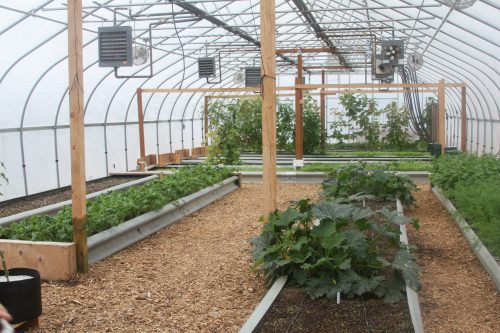Fire-hazard trees could heat greenhouses to feed rural Alaska
November 4, 2020
Heather McFarland
9074746286
Eva Dawn Burk is passionate about eating locally harvested foods, and she wants to
use them to promote healing throughout her community. It started with building fish
wheels in Nenana several years ago. She invited her community to help, and it gained
such interest she soon realized she would need to expand her fish camp to accommodate
everyone.

“I started to realize how my work with food was central to bringing my community together…in healing my community,” said Burk, a graduate student at ĐÔÓűÉç.
Now she is transitioning to include farming and growing vegetables in local food systems throughout Alaska. It's a shift she feels is important as climate change threatens the subsistence foods Indigenous people have relied on for generations.
Taking advantage of the outbreaks of spruce beetles that are devastating Alaska’s boreal forest, Burk decided to turn the fire hazard into a heat .
This fall, she received the Indigenous Communities Fellowship from , an initiative of Massachusetts Institute of Technology, to design a greenhouse and business model for Alaska villages. Burk plans to build the first greenhouse in Nenana, her hometown. She hopes the idea will spread to other Indigenous communities across Alaska.
The scheme is an innovative way to reduce fire hazards while increasing food security in communities where groceries can cost more than anywhere else in the United States.
Burk is working toward dual master’s degrees from the ĐÔÓűÉç Department of Natural Resources and Environment and the Department of Alaska Native Studies and Rural Development. She is also a graduate research assistant for the Alaska Center for Climate Assessment and Policy in the International Arctic Research Center.
Burk plans to use a strategic planning technique that puts Indigenous communities’ skills, networks and resources alongside their needs. Her framework builds off tools rural Alaskans already have access to, like the heavy equipment and manpower needed to clear the land, build a greenhouse and grow vegetables. Burk said there are even Indigenous-focused agricultural grants and biomass greenhouse plans available.

“We’re looking at this menu of assets. Everything is there. I’m just packaging it so it’s easier to understand,” said Burk.
Once the greenhouses are built, will people know how to grow veggies? That’s a problem Burk has a solution for as well. In partnership with and , she is starting an Alaska Native farmer training program. The team is taking a train-the-trainer approach, teaching potential instructors so they can take their knowledge back to other people in their communities.
This ambitious, multifaceted project could be an important step to creating a network of Indigenous farmers across Alaska. To grow awareness of the opportunities, Burk plans to share success stories through digital media.
“I’m thinking about climate change and thinking about what’s coming into the Interior Alaska. Agriculture can help us,” said Burk. “Maybe it isn’t our traditional food…but this is how we can carry on our traditions. This is how we are going to adapt.”


